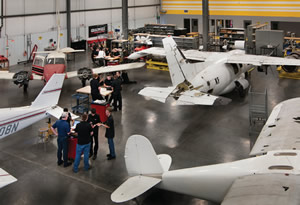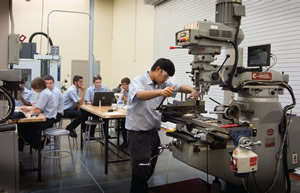Preparing for the Future
- By Pam Loeffelman
- 07/01/17

PHOTO BY NEIL KOPPES, COURTESY OF DLR GROUP
Increased globalization and technological innovations promise to seriously disrupt the futures of young generations in ways yet unknown. It’s difficult to forecast the types of jobs that today’s kindergarteners will be pursuing 15 to 20 years from now, but we do know our education models need to acknowledge this unprecedented societal change.
Applied Learning, including STEM, STEAM and Career and Technical Education (CTE), prepares students for the future by connecting secondary education, both with college expectations and labor market demands. Programs emphasize learning about applied sciences and modern technologies, and provide career preparation and trade skills. These programs are growing in popularity because of their ability to engage and connect students to real-life lessons.
This move toward Applied Learning is not a trend, it’s a pivotal shift in thinking and engagement towards preparing students for success in the world of tomorrow. With this shift comes a change in the way we create educational space: rather than space driving pedagogy, activities and the skills needed to prepare student-centric initiatives are driving the way we design educational environments.
How Applied Learning Drives Spatial Design: Two Real-World Examples
DLR Group has partnered with several districts to create educational spaces where the students of today can engage in programs that allow them to carve a clear pathway to certificates and degrees.
The Missouri Innovation Campus | Lee’s Summit, Mo. | Designed in Collaboration with Gould Evans
The Missouri Innovation Campus (MIC) represents a next generation model for education — the most accelerated degree program in the country that uniquely combines industry and academic partnerships. The MIC program expands the typical network of partners, engaging multiple K-12 school districts, dozens of regional business partners, a multi-campus community college system and a state university.
“The MIC model supports today’s students who need learning to be personalized to their generation. The building acts as a base headquarters for students who spend time on this campus, the workplace, their home high school and the community college campuses,” said Elaine Metcalf, principal of Summit Technology Academy/Missouri Innovation Campus.
This high-tech, STEM-focused facility serves 600 Lee’s Summit R-7 School District students and 1,200 University of Central Missouri students and fosters authentic workplace experiences to meet immediate industry workforce needs. The building itself supports a diverse and flexible program that can evolve as future careers are invented. Each academic focus — from networking and engineering, to medical and bio-medical, to graphics, hospitality, and cybersecurity — are segregated into quadrants with dedicated labs for specific and adjacencies to flexible spaces for a changing curriculum. MIC offers students the opportunity to graduate earlier, with much less college debt and higher job placement rates. It’s an innovative example of how program-driven spaces can help prepare our young people for a place in the professional world.

PHOTO BY NEIL KOPPES, COURTESY OF DLR GROUP
Being Prepared. In order to prepare students for success in the world of tomorrow, educational spaces need to be redesigned to accommodate activities and the tools needed to practice skills. High school and adult students on the West-MEC campus have the opportunity to receive specialty training in a variety of industry pathways, including Industrial Technology, Auto Collision and Technology, Health Sciences, Cosmetology, Veterinary Sciences, Construction Technology, Electrical, Plumbing, Pharmacy and even Aviation Technology.
Western Maricopa Education Center | Glendale, Ariz.
As Greg Donovan, Western Maricopa Education Center (West-MEC) superintendent notes, “Career and technical programs require an abundance of pre-thought and work in order to meet both industry and educational needs.”
The West-MEC campus does just that by providing a dynamic specialty training center for high school and adult students seeking future careers in a variety of industry pathways. Spread across multiple buildings, each facility presents space for hands-on learning and industry collaboration.
The Southwest Campus includes programs on Sustainable Energy, Industrial Technology; Auto Collision and Technology; Health Sciences, Cosmetology and Veterinary Sciences. Lab spaces offer state-of-theart equipment and adjacent collaborative learning spaces promote team interaction and second floor exterior roof patios enable outdoor learning environments.
The Northeast Campus hosts programs for veterinary assisting, medical assisting, HVAC-R and auto collision industries. The district also provides programs such as construction technology, electrical, plumbing and pharmacy assisting at the Northeast Campus.
The Central Campus houses West-MEC’s Aviation Technology program, teaching students aircraft maintenance and repair of mechanical systems. The facility supports a program consistent of up to 1900 hours of instruction in general, air frame, power plant and avionics as prescribed by the Federal Aviation Administration, and has the capacity to handle up to 100 enrollees per week.
In addition to these examples, DLR Group is partnering with Cherry Creek School District in Colorado to design a Career and Innovation Academy. According to Sara Grobbel, executive director of Career and Innovation, “Our new Career and Innovation Academy will inspire kids to think differently and offer them an enhanced understanding of possible pathways for career readiness.”
DLR Group’s focus on Applied Learning allows industry needs to work in tandem with academic programs, enabling the building spaces we create to help pave the way for the next generation of school design and prepare our young students for the world that awaits them.
This article originally appeared in the issue of .
About the Author
Pam Loeffelman, Principal, DLR Group. Pam leads DLR Group’s K-12 practice in the Southwest, elevating education for local school districts in Arizona, Colorado, Nevada and Wyoming. For more than 35 years Pam has been actively engaged in a dialogue about the return on investment of educational designs. She believes a combination of economic, social, and pedagogy trends, along with benchmarking can better shape the built environment so as to engage, and inspire students, educators, and local communities.